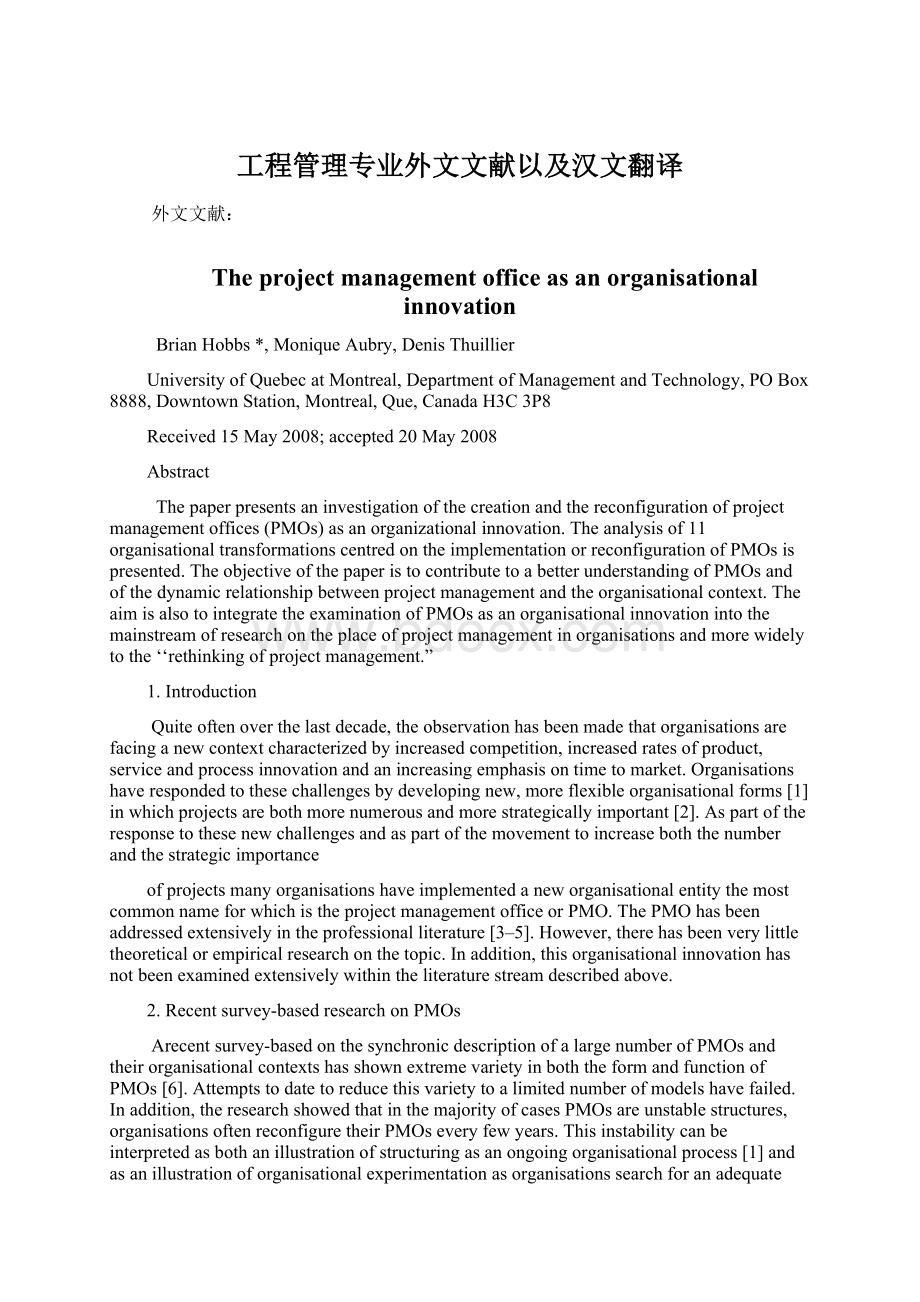工程管理专业外文文献以及汉文翻译.docx
《工程管理专业外文文献以及汉文翻译.docx》由会员分享,可在线阅读,更多相关《工程管理专业外文文献以及汉文翻译.docx(23页珍藏版)》请在冰豆网上搜索。

工程管理专业外文文献以及汉文翻译
外文文献:
Theprojectmanagementofficeasanorganisationalinnovation
BrianHobbs*,MoniqueAubry,DenisThuillier
UniversityofQuebecatMontreal,DepartmentofManagementandTechnology,POBox8888,DowntownStation,Montreal,Que,CanadaH3C3P8
Received15May2008;accepted20May2008
Abstract
Thepaperpresentsaninvestigationofthecreationandthereconfigurationofprojectmanagementoffices(PMOs)asanorganizationalinnovation.Theanalysisof11organisationaltransformationscentredontheimplementationorreconfigurationofPMOsispresented.TheobjectiveofthepaperistocontributetoabetterunderstandingofPMOsandofthedynamicrelationshipbetweenprojectmanagementandtheorganisationalcontext.TheaimisalsotointegratetheexaminationofPMOsasanorganisationalinnovationintothemainstreamofresearchontheplaceofprojectmanagementinorganisationsandmorewidelytothe‘‘rethinkingofprojectmanagement.”
1.Introduction
Quiteoftenoverthelastdecade,theobservationhasbeenmadethatorganisationsarefacinganewcontextcharacterizedbyincreasedcompetition,increasedratesofproduct,serviceandprocessinnovationandanincreasingemphasisontimetomarket.Organisationshaverespondedtothesechallengesbydevelopingnew,moreflexibleorganisationalforms[1]inwhichprojectsarebothmorenumerousandmorestrategicallyimportant[2].Aspartoftheresponsetothesenewchallengesandaspartofthemovementtoincreaseboththenumberandthestrategicimportance
ofprojectsmanyorganisationshaveimplementedaneworganisationalentitythemostcommonnameforwhichistheprojectmanagementofficeorPMO.ThePMOhasbeenaddressedextensivelyintheprofessionalliterature[3–5].However,therehasbeenverylittletheoreticalorempiricalresearchonthetopic.Inaddition,thisorganisationalinnovationhasnotbeenexaminedextensivelywithintheliteraturestreamdescribedabove.
2.Recentsurvey-basedresearchonPMOs
Arecentsurvey-basedonthesynchronicdescriptionofalargenumberofPMOsandtheirorganisationalcontextshasshownextremevarietyinboththeformandfunctionofPMOs[6].Attemptstodatetoreducethisvarietytoalimitednumberofmodelshavefailed.Inaddition,theresearchshowedthatinthemajorityofcasesPMOsareunstablestructures,organisationsoftenreconfiguretheirPMOseveryfewyears.Thisinstabilitycanbeinterpretedasbothanillustrationofstructuringasanongoingorganisationalprocess[1]andasanillustrationoforganisationalexperimentationasorganisationssearchforanadequatestructuralarrangement[7].HalfoftherespondentstothesurveyreportthatthelegitimacyoftheirPMOinitspresentformisbeingquestioned.Thisisconsistentwithboththeinterpretationintermsofexperimentationandasearchforbestpracticesandwiththeinterpretationasaninstanceoftheinherentinstabilityofanongoingprocessofstructuring.
Inthesurvey-basedresearchcitedabove,correlationanalysisfoundnosystematicrelationshipsbetweentheexternalcontextintermsofeconomicsectororgeographicregionorinternalorganisationalcontext,ontheonehand,andthestructuralcharacteristicsofPMOsontheother.NoneoftheclassiccontingencyfactorsfromorganisationaltheorycorrelatedstronglywiththeformorfunctionofthePMOs.Apositivist,synchronicapproachhasprovidedarichdescriptionofthegreatvarietyfoundinthepopulationbuthasfailed,sofar,toprovideanadequateunderstandingofPMOs.ThepresentpaperreportstheresultofanefforttocometoabetterunderstandingofPMOsasanorganisationalinnovationbasedonthein-depthinvestigationofelevencases.
3.Theliteratureonorganisationalinnovation
FoursubsetsoftheliteratureoninnovationareexaminedtoidentifyalternativeapproachesrelevanttotheexaminationofPMOsasorganizationalinnovations.First,thegeneralliteratureoninnovationisexamined.Thisisfollowedbyanexaminationoftheliteraturebasedonevolutionary,co-evolutionaryandinstitutionalisomorphismapproaches.Allaresensitivetoevolutionovertime.
3.1.Thegeneralliteratureoninnovation
Earlyresearchoninnovationhadoperatedmostlyfromaneconomicperspectiveandageneralassumptionofgrowth[8].Theinterdisciplinarycurriculumhasdevelopedovertimewiththecontributionofnewknowledgestemmingfromavarietyofsources:
economics[9–11],organisationalmanagement[12],sociology[13]andsocialecology[14].Othersprovideacategorizationofinnovationbasedonproduct,processorarchitecture[15,16].Inthisperspective,organisationsareconsideredtobeverysimilar,respondingtothesameincentives.Theobjectivesofresearchareoftentoprovideorganisationswithpracticalsolutionsdeterminingfactorstoinnovativesuccess.
Innovationtheoryisnowshiftingtoasocialinnovationapproach,broadeningtheconceptoftechnologicalinnovationtoasocialsystem.‘‘[...]thesociologicalcrucialpointisthatorganisationshavenotonlybecomeprominentactorsinsociety,theymayhavebecometheonlykindofactorwithsignificantculturalandpoliticalinfluence.Yet,recentorganisationtheoryhassurprisinglylittletosayabouthoworganisationsaffectthesociety.”[13,p.148]Newquestionshaveemergedwhichleadtomotivationtheoryandtothecontextofinnovationthatrehabilitateshistoryalongwithinnovation,thusintroducingthetemporalelementtothesocialinnovationsystem[17,18].Thishistoricalperspectivewasanaturalstepaftertheecologicalmodelwhichdemonstratedtheusefulnessofthebiologicalmetaphorwiththeconceptsofevolutionandco-evolution[19].Thissocialapproachpavedthewayforlookingatorganisationsaspartofthesocialinnovationsystemandnewformsofstructureasinnovations.Alongthislineofthought,innovationisviewedasanartor,moreexactly,asacraft[18].Innovationthenbecomesacreativeact,thedynamicconstructionofsomethingnewinwhichitcanbedifficulttodiscernanyregularpattern1[20].
3.2.Fromevolutionarytheorytoco-evolution
Theevolutionarytheorywasdevelopedinthetheoryoforganizationsbasedonabiologicalmetaphor.Abasicevolutionarymodelofanorganisationenvisionsitasacollectionofroutinesorstablebundlesofactivities.Withtime,variationoccurswithintheseroutineswiththeresultthatanygivensetofroutinesevolves,whetherintentionallyornot.Acertainnumberofnewroutinesarethenadoptedastemporarilypermanentpractices.Thissimplevariation–selection–retentionrepeatscontinuously[21,p.76].
Evolutionarytheoriesaremadeupoftwomajorgroups:
contingencytheoriesandsocialtheories.Contingencytheoriesconsidertechnologicalchangeasanexogenousphenomenonwhichtriggersorganisationalevolution[8,22].Thisdeterministicapproachmakesstructuralarrangementspredictablefromvariablessuchascomplexity,uncertaintyandinterdependency,whichcanbeintegratedintoasingledimension–theabilitytotreatinformation[23].
Socialtheoriesvieworganisationsastechnologicalsocialconstructionsinwhichthecommunityoforganisationsdeterminesthenatureoftechnologicalevolution[22].Inthisapproach,organisationalstructuresareseenasprocessesinactionwhicharecontinuouslybuiltandrebuilt[23].Scottarguesthattheseapproachesaretwosidesofthesamecoin[23].Ontheonehand,technologycanbeconsideredthecausalagentwhichshapesthestructureoforganisations;whileontheotherhand,toreversethiscausaleffect,organisationsinfluencetheinnovationprocesswitheitherthecreationofanewtechnologyoritsearlyadoption[23].
Thiscomplementarityisrecognizedintheco-evolutiontheoryinwhichtechnologicalinnovationsarebelievedtogivetheimpetusthatinitiatesnewcyclesofvariation–selection–retentionandinwhichadynamicprocessofevolutionwithinnovationconstantlyfeedsorganisation[22,24].
Massinietal.[19]confirmthatevolutionarytheoryiscapableofexplainingchangesinorganisationalstructuresandroutines.Theyconcludethatorganisationaladaptationisaconsequenceofchangesrelatedtotheadoptionoftechnologicalinnovations.LookingatlargeWesternandJapanesefirmsattwodifferentperiodsintime(1992,1996),theirresearchconfirmsboththeprogressiveadaptationovertimeandthetendencytoadoptorganisationalroutinesassociatedwithahighercapacityforflexibility.Thisalsoconfirmstheselectionandemergenceofdominantroutinessuggestedbytheevolutionarytheory.Theyalsoconfirmthatthesechangesarecontext-dependant:
theinstitutionalcontextinwhichorganisationsareembeddeddefinespatternsoforganisationalstructuresandstrategies.
3.3.Co-evolution
Inbiology,co-evolutionisdefinedasevolutioninvolvingsuccessivechangesintwoormoreecologicallyinterdependentspecies(asofaplantanditspollinators)thataffecttheirinteractions.(Merriam-Webster,11thCollegiateDictionary)Therelationcouldbeofapredator-preynatureorofasymbioticnature.Co-evolutionisalsousedinanarrowercontextwhenitreferstoaspecificformofrelation(insideoroutsideofacompany)adoptedforshorttermresults.EisenhardtandGalunic[25]refertoco-evolution(ofasymbioticnature)whentheyarguethatmulti-businesscorporationsareco-evolvingecosystems.Fromthatviewpoint,collaborationoccursonlywhenitgivesapositiveperformanceresultintermsofgrowth,sharesandprofits.
Co-evolutionhelpsusunderstandtheevolutionofcomplexsystems.Atamacro-level2,RosenkopfandTushman[22]proposeaframeworktoexaminevariousstagesofco-evolutionoforgani